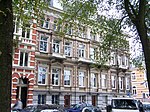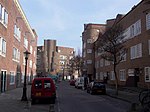Diamantbuurt (Amsterdam)
Amsterdam-ZuidNeighbourhoods of AmsterdamNorth Holland geography stubs

The Diamantbuurt is a neighborhood of Amsterdam, The Netherlands. It was built in the 1930s. It has streets named after precious stones: Diamantstraat, Robijnstraat, Saffierstraat, Smaragdstraat, Topaasstraat and Granaatstraat. These days the Diamantbuurt includes the area enclosed by the Tweede van der Helststraat, Karel du Jardinstraat, Henrick de Keijserplein, Tolstraat, Amstel and Amstelkanaal. It has many special buildings and monuments, like social housing in the Amsterdam School style of architecture.
Excerpt from the Wikipedia article Diamantbuurt (Amsterdam) (License: CC BY-SA 3.0, Authors, Images).Diamantbuurt (Amsterdam)
Diamantstraat, Amsterdam
Geographical coordinates (GPS) Address Nearby Places Show on map
Geographical coordinates (GPS)
| Latitude | Longitude |
|---|---|
| N 52.350833333333 ° | E 4.9063888888889 ° |
Address
Diamantstraat 142
1074 GG Amsterdam
North Holland, Netherlands
Open on Google Maps









